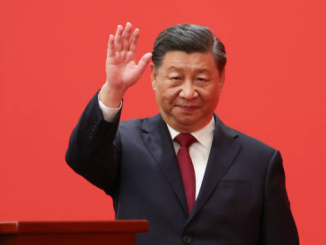
North Korean leaders threatened potential nuclear retaliation over America’s presence in the region for the second time this month, following the docking of a U.S. submarine in South Korea.
The U.S deployed the nuclear-armed USS Kentucky, which arrived at the South Korean port of Busan earlier this week.
The presence of the Ohio-class submarine marks the first visit with a U.S. SSBN to South Korea since the 1980s.
According to Pyongyang’s Defense Minister Kang Sun-nam, the arrival of the USS Kentucky could give North Korea the greenlight to launch a nuclear attack.
Following the submarine’s arrival to Busan, North Korea fired two ballistic missiles eastwards.
North Korea Makes a Big Threat…
The current ramp up in Pyongyang’s hostilities began nearly two weeks ago, when the Democratic People’s Republic of Korea (DPRK) accused the US of violating its airspace by conducting“spy” flights.
Sister of the North Korean leader Kim Jong Un cautioned that “shocking” consequences would emerge if America continues to allow reconnaissance to fly in its airspace.
Seoul said that Pyongyang’s claim of violating airspace is inaccurate, as American airframes legally conduct routine reconnaissance flights around the peninsula.
This accusation followed closely behind the 73rdanniversary of the Korean War, which Pyongyang marked by mobilizing tens of thousands of anti-American protests in the capital.
According to North Korean media, protestors expressed glee surrounding their country’s expanding nuclear and missile programs, insisting that Pyongyang now has the “strongest absolute weapon to punish the U.S. imperialists and the war deterrence for self-defense which no enemy dare provoke.”
North Korea’s expanding nuclear arsenal…
Over the years, subsequent U.S. administrations have tried to thwart Pyongyang’s nuclear advancements.
Back in the 1980’s, North Korea signed the Nuclear Nonproliferation Treaty (NPT). A few years later, the governments of Seoul and Pyongyang agreed to abstain from nuclear development programs in a joint pledge to denuclearize the peninsula.
Over the next few decades, any hope for a nuclear-free North Korea began to diminish.
In 2002, North Korea officially exited the NPT, after admitting to running an underground uranium-enrichment program that violated the commitments listed in the NPT and its bilateral agreement with South Korea.
The Kim Jong Un government frequently condemns America’s involvement in the region, using U.S.-Japanese-South Korean relations as an excuse to spew dangerous rhetoric.
In May, Washington and Seoul completed their joint exercise called “combined annihilation firepower drills.”
Since the late 1970s, the two countries have carried out the collaborative set of military drills 11 times. Pyongyang views U.S.-South Korean cooperation as a direct threat to its existence.
Pyongyang has launched 100 missiles since 2022
While the recent uptick in North Korean rhetoric and weapon launches are concerning, this behavior is not new. In fact, since the start of 2022, the DPRK has launched roughly 100 missiles. Many of the nuclear-capable weapons launched could reach the U.S. mainland, South Korean and Japan.
In April, the Hermit Kingdom launched what it calls the most advanced weapon in its possession- the Hwasong-18.
The solid-fuel missile reportedly flew about 1,000km on its maiden flight, according to the Center for Strategic and International Studies.
This month, Pyongyang was able to launch a Hwasong-18 that flew for over 74 minutes at an altitude of more than 6,000 km.
* Article From: 19fortyfive


